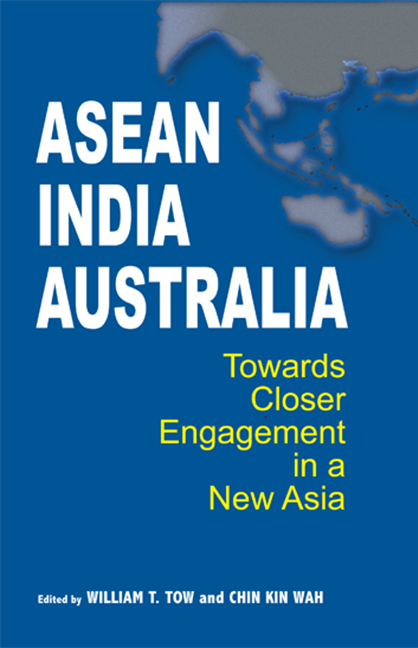Book contents
- Frontmatter
- Contents
- Preface
- Contributors
- List of Abbreviations
- Introduction
- Part I Emerging Regional Security
- 1 Emerging Regional Security Architecture: An Australian Perspective
- 2 Emerging East Asian Regional Architecture: ASEAN Perspectives
- 3 India in the Emerging Asian Architecture: Prospects for Security Cooperation with ASEAN and Australia
- 4 ASEAN, Australia, and India in Asia's Regional Order
- Part II Energy Security
- Part III Climate Change
- Part IV Maritime Security
- Part V Law Enforcement/Combating International Crime
- Conclusion
- Bibliography
- Index
2 - Emerging East Asian Regional Architecture: ASEAN Perspectives
from Part I - Emerging Regional Security
Published online by Cambridge University Press: 21 October 2015
- Frontmatter
- Contents
- Preface
- Contributors
- List of Abbreviations
- Introduction
- Part I Emerging Regional Security
- 1 Emerging Regional Security Architecture: An Australian Perspective
- 2 Emerging East Asian Regional Architecture: ASEAN Perspectives
- 3 India in the Emerging Asian Architecture: Prospects for Security Cooperation with ASEAN and Australia
- 4 ASEAN, Australia, and India in Asia's Regional Order
- Part II Energy Security
- Part III Climate Change
- Part IV Maritime Security
- Part V Law Enforcement/Combating International Crime
- Conclusion
- Bibliography
- Index
Summary
Defining “regional architecture”
The term “regional architecture” is often used loosely or with scant prior clarification — presuming we all know what it refers too. A useful working definition is provided by Brendan Taylor and Bill Tow in their paper “Asia Pacific Security Architecture” prepared for an International Alliance of Research Universities Conference on Security held in November 2006. They used “architecture” in a collective sense to refer to the institutions, including other structures, which together comprise it. Attention is drawn to the “number, style and arrangement of those individual institutions and activities” that “combine and form an overall architecture”. Although the main focus of their paper is on security in the Asia-Pacific, the definition is relevant to our discussion here which looks essentially at the “East Asian” region in a broad political rather than narrow geographic sense. Of particular relevance to the East Asian endeavour is their observation that the “architecture” referred to is essentially a work in progress — “not static and meticulously planned, but as something that is organic, constantly growing and developing”. Citing Hanns Maull, they see it very much as “the work of several competing architects, rather than one master builder”. Such a composite definition which they worked out essentially in a “security” context (hence the use of “security” to qualify “architecture”) remains pertinent to our discussion here that relates to a loosely defined East Asian region. Although we focus here on regional rather than security architecture, an underlying assumption is the interconnectedness between security and other concerns in the realms of trade, economic cooperation, and energy security, as well as the environment, among others which may have their own functional frameworks and structures to facilitate cooperation, but which nevertheless can be related back to or subsumed within the broad regional architecture.
This section of the book seeks to address the question of how ASEAN, India, and Australia see their respective roles and interests within the East Asia Summit (EAS) process that is shaping a certain regional architecture, and how they would like to see it develop with reference to other big players outside it — particularly the United States, the European Union, and Russia. The specific task of this chapter is to focus on the ASEAN leg of the ASEAN-India-Australia triad.
- Type
- Chapter
- Information
- ASEAN-India-AustraliaTowards Closer Engagement in a New Asia, pp. 22 - 39Publisher: ISEAS–Yusof Ishak InstitutePrint publication year: 2009



